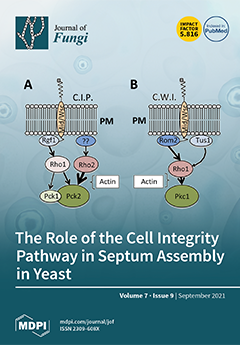Candida lusitaniae is an opportunistic pathogen in humans that causes infrequent but difficult-to-treat diseases. Antifungal drugs are used in the clinic to treat
C. lusitaniae infections, however, this fungus can rapidly acquire antifungal resistance to all known antifungal drugs (multidrug resistance).
C. lusitaniae acquires azole resistance by gain-of-function (GOF) mutations in the transcriptional regulator
MRR1.
MRR1 controls the expression of a major facilitator transporter (
MFS7) that is important for fluconazole resistance. Here, we addressed the role of the ATP Binding Cassette (ABC) transporter
CDR1 as additional mediator of azole resistance in
C. lusitaniae. CDR1 expression in isolates with GOF
MRR1 mutations was higher compared to wild types, which suggests that
CDR1 is an additional (direct or indirect) target of
MRR1.
CDR1 deletion in the azole-resistant isolate P3 (V688G GOF) revealed that MICs of long-tailed azoles, itraconazole and posaconazole, were decreased compared to P3, which is consistent with the role of this ABC transporter in the efflux of these azoles. Fluconazole MIC was only decreased when
CDR1 was deleted in the background of an
mfs7Δ mutant from P3, which underpins the dominant role of
MFS7 in the resistance of the short-tailed azole fluconazole. With R6G efflux readout as Cdr1 efflux capacity, our data showed that R6G efflux was increased in P3 compared to an azole-susceptible wild type parent, and diminished to background levels in mutant strains lacking
CDR1. Milbemycin oxim A3, a known inhibitor of fungal ABC transporters, mimicked efflux phenotypes of
cdr1Δ mutants. We therefore provided evidence that
CDR1 is an additional mediator of azole resistance in
C. lusitaniae, and that
CDR1 regulation is dependent on
MRR1 and associated GOF mutations.
Full article






